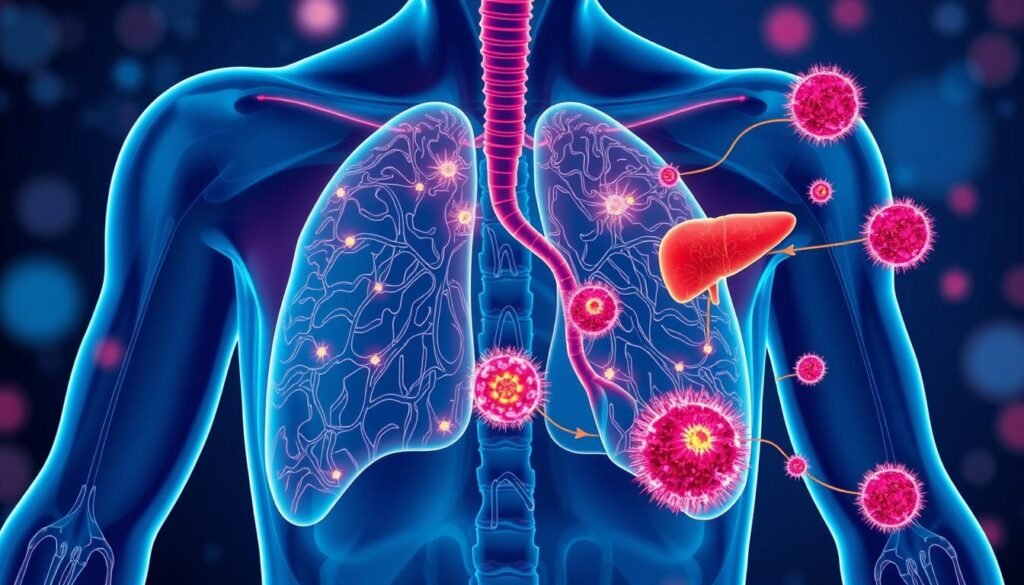Lung cancer causes about 25% of all cancer deaths in the United States. It’s important to know how it can spread to the brain, liver, and bones. The two main types, NSCLC and SCLC, often move to the brain. Knowing about this can help find effective treatments early.
When lung cancer spreads, it brings big challenges for patients and doctors. It’s key to understand this spread to help patients better. For more on treatments and effects of spreading, check this informative article.
Key Takeaways
- Lung cancer is a leading cause of cancer-related deaths in the U.S., accounting for 25% of such fatalities.
- Brain metastases occur in 34.5% of NSCLC cases and 21.4% of SCLC cases.
- All lung cancer patients with brain metastases commonly present neuropsychiatric symptoms.
- Bone metastasis can cause severe complications, including pain and fractures.
- Understanding lung cancer’s spread is vital for enhancing treatment strategies and patient care.
Understanding Lung Cancer and Its Metastasis
Lung cancer begins when abnormal cells inside the lungs grow without control. It’s mainly split into two types: non-small cell lung cancer (NSCLC) and small cell lung cancer (SCLC). Lung cancer metastasis happens when these cancer cells move from the original tumor. They travel through blood or lymph to other organs, forming more tumors.
This change marks lung cancer as a systemic disease. Once it spreads far, chances of surviving go down a lot. This makes fighting cancer harder when it reaches distant parts of the body.
Late-stage lung cancer can’t usually be cured. But, there are treatments that help control symptoms and improve life for patients. Often, the cancer is found at advanced stages or after it returns. It’s then called locally advanced lung cancer, spreading to nearby tissues and lymph nodes.
The cancer often spreads to lymph nodes, brain, bones, liver, and adrenal glands. It’s tough for those facing such news. Support and clear info are crucial. Life expectancy can vary a lot, making it important to talk to specialists for advice that suits your case.
Experts have created detailed guides for treating lung cancer. Knowing how it spreads, especially through blood, helps in finding better ways to tackle it.
Brain metastases are especially common in certain types of lung cancer. They show the cancer is advancing. Supportive care helps improve life quality during this time. It includes things like hospice, or therapy to keep you active.
Dealing with cancers that spread needs a team approach for care. This ensures patients get comprehensive care on their journey.
How Lung Cancer Spreads to Different Organs
Lung cancer moves in complex ways, mainly through two pathways of metastasis: blood and lymphatic. This means the cancer cells might spread through blood or lymph systems. They can travel to different body parts, causing serious organ involvement.
About 57% of lung cancer cases are found after it has spread. For those with non-small cell lung cancer (NSCLC), 20 to 30% have it reach their bones. Eventually, 35 to 60% of them will see it spread to bones, showing how aggressive it is.
Brain metastases affect 10 to 50% of lung cancer patients. The brain’s special blood vessels make it a common target. Sometimes, lung cancer reaches unusual areas like the eyes, kidneys, and even the skin.
The liver is a key site where cancer metastasis can be worrying. Often, once it gets to the liver, curing it is tough. Signs include fever and jaundice, but some people don’t feel sick at first.

The five-year survival rates for metastatic lung cancer are quite low. Stage 4 non-small cell lung cancer has an 8% survival rate if it spreads far. If cancer spreads close by, the rate goes up to 37%. Small cell lung cancer’s outlook is harsher, with a 3% survival rate for distant spread, improving to 18% for regional spread.
Treating advanced lung cancer depends on where and how much it has spread. Options include surgery, chemo, targeted treatments, and immune therapy. Adding palliative care helps improve life quality by dealing with emotional and physical pain. It ensures patients have full support during their treatment.
Common Sites of Metastasis: Brain, Liver, and Bones
Lung cancer often spreads to the brain, liver, and bones. Each of these places can show different symptoms and present unique challenges for doctors. Knowing about these metastatic sites helps in giving better care and treatment to those with lung cancer.
Brain Metastases: Symptoms and Diagnosis
Brain metastases are a big worry for lung cancer patients. They can cause neuropsychiatric symptoms like headaches, feeling dizzy, and having trouble thinking. These make diagnosing brain metastasis complicated. Doctors usually need to do MRI and CT scans to find them. Lung cancer more often leads to brain metastases compared to other cancers. It’s crucial to spot these signs early to start treatment right away.
Challenges in Diagnosing Brain Metastases
Doctors find it tough to diagnose brain metastases. The symptoms can mimic other brain disorders, leading to possible delays. Many people with lung cancer don’t show obvious signs of metastasis at first. This makes it hard to find early. Moreover, usual tests might not catch small lesions. For patients with advanced lung cancer, doctors must be very careful to check for brain cancer detection.

Impact of Liver Metastases on Patient Health
Liver metastases often mean a critical stage of lung cancer. They change how doctors treat the cancer and affect patient health impact. This condition is found in many cancers, not just lung cancer. It’s a key focus in caring for patients. Symptoms like jaundice, stomach pain, and losing weight hurt a patient’s life quality. People often feel less hungry, tired, and have belly pain.
Treating this condition includes different therapies based on what the patient needs. Chemotherapy is usually the main treatment. Other options might be targeted therapies and immunotherapy. These treatments try to slow the cancer spread. They help improve life quality for those with liver cancers.
The outlook for liver metastases patients is often not good because of how serious the symptoms are. Studies show these patients live shorter lives than those with cancer spread to the brain or bone. This big difference shows why catching cancer early is key. It also highlights why ongoing research is essential. It helps find those at higher risk for such issues. More information is available through studies on predictive outcomes.

| Symptom | Impact on Quality of Life |
|---|---|
| Loss of Appetite | Increased fatigue and weakness |
| Jaundice | Emotional distress, social stigma |
| Abdominal Pain | Interferes with daily activities |
| Weight Loss | Reduction in physical strength |
| Fatigue | Decreased ability to perform tasks |
| Nausea | Limits food intake and hydration |
Liver metastases bring big challenges. There’s a big need for well-rounded treatment plans. These plans help lessen the patient health impact. They also make life better for patients. Keeping up with check-ups and new treatments is key. Research is always finding new ways to help.
Lung Cancer Spread to Brain, Liver, and Bones: Clinical Implications
Lung cancer spreading to areas like the brain, liver, and bones is serious. It means doctors must manage the disease with care. About 14.1% of people with lung cancer will find it has spread to their brain. This requires a team of experts like oncologists and neurologists to work together.
Those with brain metastases might have headaches, memory problems, seizures, and trouble with balance. These symptoms make treating cancer more complex. Doctors may use surgery, radiation, targeted therapy, or immunotherapy to treat these metastases. What treatment they choose depends on the patient’s age and other health issues.
Risk factors for brain metastasis are crucial to understand. For instance, patients with lung cancer that has spread to the liver or bones may be more likely to have it spread to the brain. And, managing cancer can be harder for older patients, especially those over 80.
Places like the Mayo Clinic offer support and resources for people fighting spread-out cancer. They show the importance of adding supportive care into cancer treatment plans. This helps improve the lives of those dealing with cancer.
| Treatment Option | Description | Application |
|---|---|---|
| Surgery | Involves the removal of tumors from the brain. | Effective for accessible brain tumors, potentially prolonging survival. |
| Radiation Therapy | Uses high-energy rays to target and kill cancer cells. | Suitable for multiple brain metastases or when surgery is not feasible. |
| Targeted Therapy | Targets specific genetic markers or pathways involved in cancer growth. | Focuses on individual tumor characteristics for tailored treatments. |
| Immunotherapy | Stimulates the immune system to fight cancer. | Gaining traction as an option for certain patients. |
Strategies for Managing Bone Metastases
Bone metastases harm skeletal health and overall well-being. A strategic approach is needed for managing skeletal-related events (SREs). These include fractures and spinal cord compression. Quick action is needed to handle symptoms and keep up the quality of life.
Understanding Skeletal-Related Events (SREs)
Skeletal-related events are complications from bone metastases. They often affect the spine, pelvis, femur, and other areas. These parts are at risk for severe problems like:
- Bone pain, often signaling metastatic spread.
- Fractures, mainly in the spine and long bones.
- Nerve damage, which can lead to paralysis if not treated.
- High blood calcium levels, causing confusion and other issues.
Recognizing symptoms early and treating them well can lessen complications. Imaging tests such as X-rays and MRI scans are crucial. Treatments include drugs like zoledronic acid and pamidronate. These help slow bone loss and ease pain. Another option is denosumab, effective in preventing SREs and improving safety.
A comprehensive pain management plan is vital for suffering patients. It is also important to keep up with oral hygiene and dental visits. This avoids severe outcomes like osteonecrosis of the jaw linked to some treatments.
Using these methods together shapes a full care plan for cancer patients. Adding preventive actions, like calcium and Vitamin D, helps treatment work better. With teamwork, patients can face bone metastases challenges better. It helps improve life quality while dealing with bone issues.
Advanced Treatments for Metastatic Lung Cancer
The treatment world for metastatic lung cancer has changed a lot, leading to better patient outcomes. Doctors now use targeted therapies and better chemotherapy plans. This way, they can create treatments that fit each patient’s cancer specifically.
Targeted Therapies and Chemotherapy Options
Targeted therapy is key in battling metastatic lung cancer. EGFR inhibitors, like erlotinib, have shown promise for patients with certain genetic changes. There are also new therapies for ALK and KRAS G12C mutations that help chemotherapy work better.
For stage 4 lung cancer, doctors often pair drugs like cisplatin with gemcitabine. These methods aim to fight the cancer and control symptoms. It’s important for patients to talk with their doctors about how these treatments can help and what side effects may happen.
Role of Palliative Care in Metastatic Disease
Palliative care is very important for people with metastatic lung cancer. It helps handle symptoms and the emotional challenges that come with cancer. A team of specialists work together to ease pain and improve quality of life.
Starting palliative care early leads to happier patients. It focuses on easing symptoms for better outcomes. This approach balances aggressive treatment and supportive care, making a big difference for those facing metastatic lung cancer.
Conclusion
Dealing with metastatic lung cancer is tough, especially when it spreads to the brain, liver, and bones. This major health issue changes how doctors choose treatments. It also deeply affects how patients feel about their lives. Understanding more about this disease helps patients and doctors make better choices.
Studies keep finding important information about risk factors and what happens after the disease spreads. Today, there are new treatments aimed right at the cancer. There’s also care aimed at making patients feel better. Teams of doctors from different areas work together to give the best care. This teamwork is key to taking care of patients with metastatic lung cancer.
Hope is on the horizon with progress in research. These advances could lead to better survival rates and improve patients’ lives. Putting focus on preventing the disease and teaching people about it is crucial. This approach could lift the way lung cancer is handled, helping many people in need of support and new treatment options.